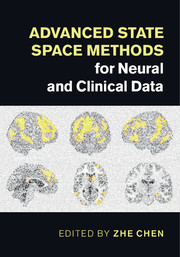Book contents
- Frontmatter
- Contents
- List of contributors
- Preface
- Introduction
- Inference and learning in latent Markov models
- Part I State space methods for neural data
- State space methods for MEG source reconstruction
- Autoregressive modeling of fMRI time series: state space approaches and the general linear model
- State space models and their spectral decomposition in dynamic causal modeling
- Estimating state and parameters in state space models of spike trains
- Bayesian inference for latent stepping and ramping models of spike train data
- Probabilistic approaches to uncover rat hippocampal population codes
- Neural decoding in motor cortex using state space models with hidden states
- State space modeling for analysis of behavior in learning experiments
- Part II State space methods for clinical data
- index
- References
Neural decoding in motor cortex using state space models with hidden states
from Part I - State space methods for neural data
Published online by Cambridge University Press: 05 October 2015
- Frontmatter
- Contents
- List of contributors
- Preface
- Introduction
- Inference and learning in latent Markov models
- Part I State space methods for neural data
- State space methods for MEG source reconstruction
- Autoregressive modeling of fMRI time series: state space approaches and the general linear model
- State space models and their spectral decomposition in dynamic causal modeling
- Estimating state and parameters in state space models of spike trains
- Bayesian inference for latent stepping and ramping models of spike train data
- Probabilistic approaches to uncover rat hippocampal population codes
- Neural decoding in motor cortex using state space models with hidden states
- State space modeling for analysis of behavior in learning experiments
- Part II State space methods for clinical data
- index
- References
Summary
Introduction
Loss of functions is a common problem in this real world. Human beings often suffer from various diseases and traumas which include visual, auditory and motor impairments, for example: blindness, deafness, brainstem stroke, ALS (amyotrophic lateral sclerosis) and spinal cord injury. Current investigations search for an interface between the brain and external devices to restore these functions. New technical terms such as “neural prostheses,” “brain–machine interface (BMI),” “brain–computer interface (BCI)” are broadly appearing in up-to-date research articles as well as other media.
Fast developments in biotechnology have given us the ability to measure and record population neuronal activity with more precision and accuracy than ever before, allowing researchers to study and perform detailed analyses which may have been impossible just a few years ago. In particular, with this advancement in technology, it is now possible to construct an interface to bridge the gap between neuronal spiking activity and external devices that help control real-world applications (Lebedev & Nicolelis 2006; Schwartz et al. 2006; Homer et al. 2013). The primary goal of this research is to be able to restore motor function to physically disabled patients (Hochberg et al. 2006): spike recordings would be “decoded” to provide an external prosthetic device with a neurally controlled signal in the hope that the movement can be restored in its original form.
Pioneer work was conducted over the past decade in several research groups which demonstrated that hand movement can be represented by the neural activity of a population of cells in monkey's motor cortex (Schwartz & Moran 1999; Wessberg et al. 2000; Serruya et al. 2002). They also developed various mathematical algorithms to infer the hand motion with real-time performance. The results were noteworthy: the inference was fast and the estimation was accurate enough to perform a neural control task. Their work also demonstrated that the direct neural tasks can be successfully accomplished using the proposed algorithms (Wessberg et al. 2000; Serruya et al. 2002; Taylor et al. 2002). However, there are still various issues that need to be addressed, such as longterm stability of the micro electrode array implants, efficacy and safety, low power consumption, and mechanical reliability (Donoghue 2002; Chestek et al. 2007; Homer et al. 2013).
- Type
- Chapter
- Information
- Advanced State Space Methods for Neural and Clinical Data , pp. 207 - 230Publisher: Cambridge University PressPrint publication year: 2015
References
- 1
- Cited by

